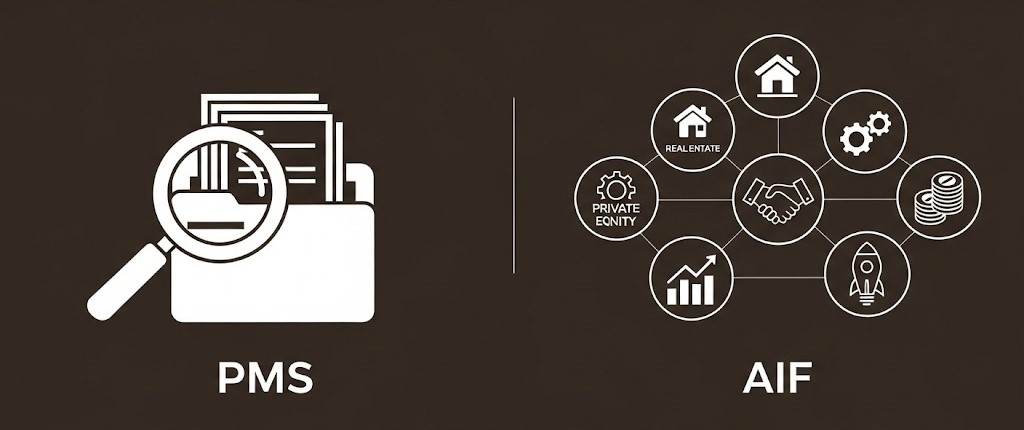PMS vs AIF : A Complete Guide to Choosing the Right Investment Strategy
As India’s wealth management landscape evolves, Portfolio Management Services (PMS) and Alternative Investment Funds (AIFs) have emerged as sophisticated options for high-net-worth individuals (HNIs) seeking alpha beyond mutual funds and fixed income.
Though both PMS and AIF are regulated by SEBI and cater to HNIs, they differ significantly in terms of structure, strategy, liquidity, taxation, and investor experience.
This detailed guide walks you through the key differences between PMS and AIF, helping you make informed investment decisions.
1. What is PMS?
Portfolio Management Services (PMS) is a bespoke investment solution where your money is managed individually in your own Demat account.
Key Features:
- Direct ownership of stocks and securities
- Customized portfolio based on your goals
- Transparent reporting and real-time tracking
- Active equity or debt strategies
- Regulated under SEBI (Portfolio Managers) Regulations, 2020
Ideal For:
Investors who want:
- Full visibility into their holdings
- Liquidity with flexibility
- Tailored portfolio design
- Minimum ticket size: ₹50 lakhs
What is AIF?
Alternative Investment Funds (AIFs) are pooled investment vehicles that raise capital from investors and deploy it across alternate asset classes such as unlisted equity, real estate, venture capital, and long-short strategies.
Key Features:
- Investors receive units in a pooled structure
- No direct ownership; returns are based on NAV
- Operate under a trust structure
- Regulated under SEBI (AIF) Regulations, 2012
AIF Categories:
| Category | Description | Examples |
| Category I | Early-stage, social venture, infrastructure | VC funds, SME support funds |
| Category II | Private equity, debt, real estate, structured credit | PE funds, credit funds |
| Category III | Complex hedge or long-short strategies, leverage allowed | Long-short equity, quant funds |
Ideal For:
Investors seeking access to:
- Private markets & alternative assets
- High-risk/high-reward strategies
- Tax-optimised pooling structures
- Minimum investment: ₹1 crore
3. PMS vs AIF : Feature-by-Feature Comparison
| Feature | PMS | AIF |
| Structure | Individually managed a Demat account | Pooled trust/fund structure |
| Ownership | Direct ownership of securities | Unit-holder in a pooled investment |
| Minimum Investment | ₹50 lakhs | ₹1 crore |
| Liquidity | Flexible (T+2 exits, subject to exit loads) | Complete Liquidity in Category 3 AIFs; typically 5–7 year lock-ins in Category 2 Funds |
| Taxation | At the investor level | Pass-through (Cat I & II); Fund-level (Cat III) |
| Strategy Range | Primarily listed equities, some debt | Listed + Unlisted + Derivatives + Real Assets |
| Risk | Moderate to high | Moderate to high |
| Transparency | High (real-time tracking) | Medium (Monthly NAV and Quarterly reports) |
| Suitability | HNIs seeking flexibility, direct equity exposure | HNIs/Institutions seeking differentiated investing options other than traditional assets. |
Liquidity and Exit Options in PMS and AIF Investments
| Type | Liquidity |
| PMS | Generally liquid, subject to exit load (1–3 years) |
| AIF | Category I & II: Close-ended, no early exit (3–7 yrs) |
| Category III: Allows monthly redemptions |
Taxation in PMS vs AIF: What Investors Should Know
1. PMS Taxation:
- Gains taxed at investor level
- Equity STCG: 20% | LTCG: 12.5% (after ₹1L exemption)
- Debt/STCG taxed per slab
- Losses can be offset by investor
2. AIF Taxation:
- Category I & II: Pass-through taxation
- Investor pays tax based on distributed gains
- Category III: Taxed at fund level
- No tax filing needed by investor
PMS vs AIF – Which Should You Choose?
Choose PMS if:
- You want direct ownership of stocks
- You prefer flexibility and liquidity
- You want to see portfolio movements in real time
- You seek transparency in holdings and taxation
Choose AIF if:
- You’re seeking private equity, pre-IPO, or real estate exposure
- You’re not comfortable in managing taxes yourself.
- You’re okay with delegated management in a pooled fund
- You want exposure to hedge, long-short, or credit strategies
Ready to Invest? How to Decide Between PMS and AIF
At PMS AIF WORLD, we help you:
- Evaluate PMS and AIFs based on our 5P framework
- Understand risk, taxation, and long-term implications
- Compare options across 100+ SEBI-registered PMS & AIFs
- Make smart, personalized wealth allocation decisions
Disclaimer: Securities investments are subject to market risks and there is no assurance or guarantee that the objective of the investments will be achieved. The statements contained herein may include statements of future expectations and other forward-looking statements that are based on our current views and assumptions and involve known and unknown risks and uncertainties that could cause actual results, performance or events to differ materially from those expressed or implied in such statements
Do Not Simply Invest, Make Informed Decisions
WISH TO MAKE INFORMED INVESTMENTS FOR LONG TERM WEALTH CREATION


